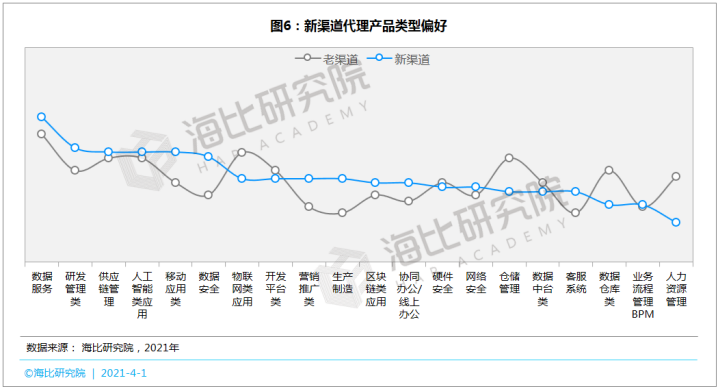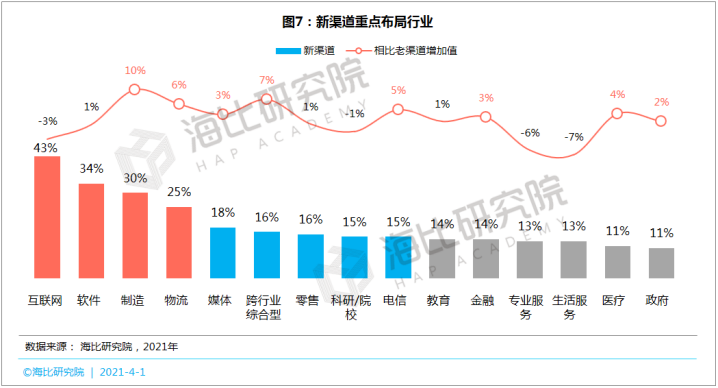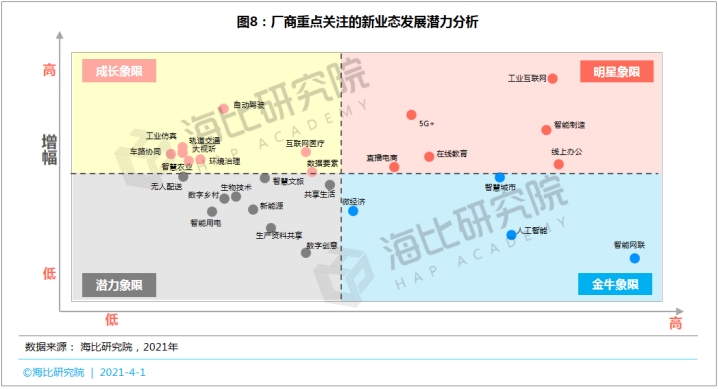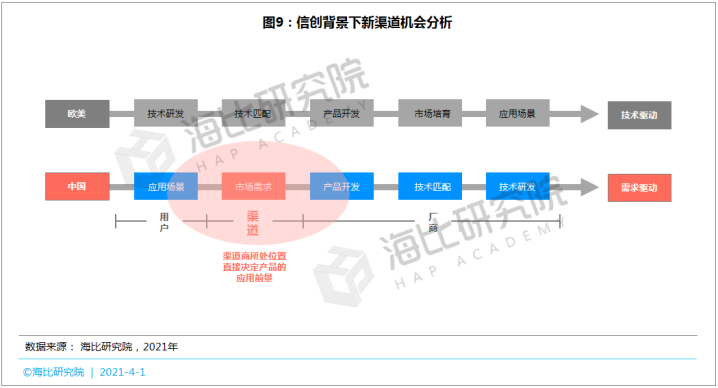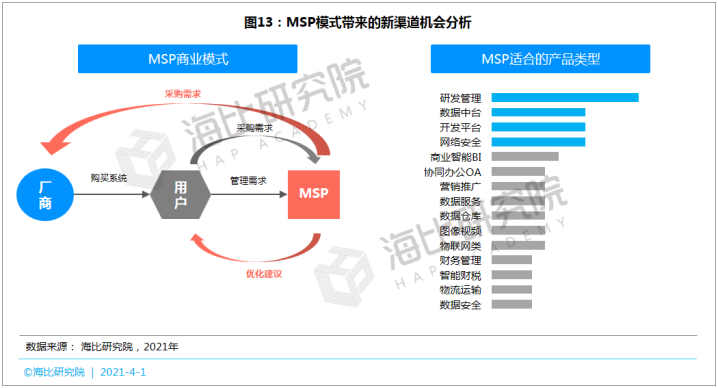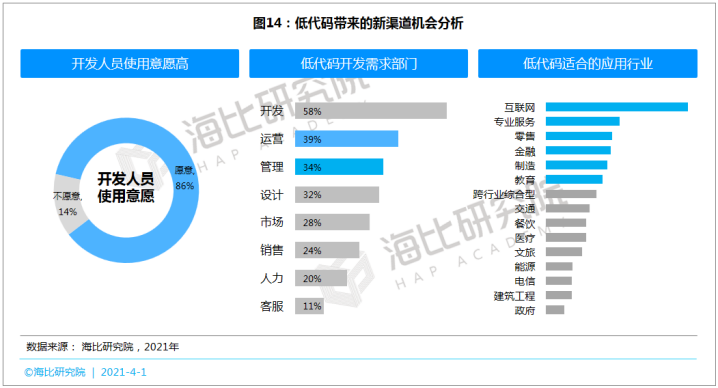Interpretation of 2021 the number of Chinese enterprises intellectual development of ecological research report: channel development strategy analysis and proxy
Editor’s note: This article is from the micro-channel public number “in Chile to observe” (ID: Hapiweb-soft6), Author: Heby Institute .
In the past year’s market research, Heby Research Institute found that the level of digitalization in the Chinese market has been unprecedentedly improved, and the demand for corporate digital construction continues to be strong. A large number of new application scenarios have emerged in the process of corporate digital transformation, which has led to many new The demand for digital and intelligent products, and the pursuit of new technologies by enterprises is generally high.
In particular, new products represented by SaaS and PaaS have been widely used in the digital construction of enterprises. When these new demands and new products produced by new technologies are put on the ground, many new business formats and new models have begun to derive.
Therefore, the Haibi Research Institute hopes to focus on this research to discuss how channel vendors should transform after the emergence of new technologies, new products, new models, and new business formats to adapt to the emergence of these new needs, so as to facilitate better services With upstream manufacturers and downstream users.
In the existing digital market, there are endless reports on vendors, users, and vertical industries. However, market research reports that really focus on channel business groups are still relatively rare. Haibi Research Institute hopes to systematically sort out the development history of channel vendors. Study the types of channel vendors, and clarify which channel vendors are new-type channel vendors that are in line with the market development trend at this stage, and which channel vendors need to face transformation in order to improve their competitiveness, so as to provide channel vendors with a panoramic view of the overall industry Observe the window and contribute to the transformation and development of channel business.
01 Channel business development history:
The development of channel vendors has evolved four times and is now in the era of regional ecological partners, but more than 90% of channel vendors are still in the 2.0 era, and traditional channel vendors continue to upgrade
The development of channel vendors has gone through four stages. In the 1.0 era of channel vendors (called product sales partners), they mainly met the manufacturers’ product sales needs, and in the 2.0 era (called sales and service partners), service requirements were increased. Evolved to the 3.0 era and added solution capabilities (called solution service partners), and now channel vendors have evolved to the 4.0 era (called regional ecological partners), adding personalized customization capabilities, which can be said to be the evolutionary history of channel vendors It is the rich history of the scope of services.
From the performance of the four types of core capabilities, channel business 1.0It is necessary to improve the ability to meet the solution integration and custom development in order to better serve users and manufacturers, better integrate new technologies, and promote the application of new products and the landing of new formats. This is also an important reason why we call on channel vendors to transform into new channels.
The emergence of the five new ecology has reshaped the industrial structure, filled the gap in diversified and customized demands brought about by industrial integration, and further improved the traditional industrial structure. As the hub of the Five New Ecosystems, new channels play a vital role in the reshaping of the entire industrial structure. However, the problem is that only 6.7% of channel vendors are new channels that meet these capability standards at this stage. The market urgently needs traditional channels. Business upgrade and transformation into new channels.
03 New channel business model
New channels connect with diversified vendor groups to meet user customization needs
The business model in the era of product sales partners is that manufacturers first find channels and then users, while the typical model in the era of sales service partners is that channels first find users and then match manufacturers’ products according to their needs.
The biggest feature of the new channel business model is that the upstream docks with many manufacturers and integrates products into solutions to meet the diverse, rich, and personalized application needs of downstream users.
As the link between manufacturers and users, new channels must not only integrate into the ecosystem of upstream manufacturers, integrate their diversified products into their own solutions or customized solutions, but also timely meet the personalization and personalization of downstream users. Fragmented scenario application requirements can quickly provide matching solutions and customized development and implementation capabilities. This is why the core competence requirements of the new channel are solution capabilities, diversified customization capabilities, and new technical support capabilities. Its business model determines the importance of these three capabilities.
04 New channel service capabilities:
Diversified scenario customization, solutions, and technical support capabilities will be the important service content of the new channel
From the survey results, the first of the new channel service capabilities is the ability to provide one-stop customized services for diversified scenarios, followed by professional technical support capabilities, and overall solution services for the development of individual needs and specific scenarios. , Software implementation, etc. are also paid more attention.
The old channel focuses on technical support services first, followed by software implementation services, and again for diversified scenarios customization capabilities, personalized demand development capabilities, and consulting services.The product.
It can be seen that new channels will choose more technologically advanced new product types when choosing agency products, and they are all product types that are catalyzed by the new needs of current customers. The old channels prefer the traditional old software product types, basically focusing on maintaining the needs of old customers, and not focusing on the layout and efforts of new customers’ new needs. If the old channel wants to transform into a new channel, it will be more effective to start with product types that meet the new needs of new customers.
07 New channel key industries:
New channels are more suitable for key layout in manufacturing, logistics, media, telecommunications, finance, medical and government industries
The first echelon of the industry that the new channel focuses on is the Internet, software, manufacturing, logistics, and the second echelon is media, cross-industry integrated, retail, scientific research/academics, telecommunications, and education, finance, and professional services. , Life services, medical care, and the government are also concerned.
Compared with the old channels, the layout of the new channels in manufacturing, logistics, media, cross-industry integrated, telecommunications, finance, medical and government industries has increased significantly, and these industry scenarios are precisely the new technologies and new products. Hot application landing scenarios. Therefore, if old channels want to upgrade to new channels, they can start with these industries first in terms of industry selection.
08 new channel hot business:
Industrial Internet, smart manufacturing, online office, online education, 5G+ and live broadcast e-commerce are star formats
From the perspective of the development of emerging business formats, industrial Internet, smart manufacturing, online office, online education, 5G+ and live e-commerce applications are the best, with a high market share and a large increase, and they belong to the star quadrant.
Intelligent network connection, smart city, artificial intelligence, and micro-economy belong to the Taurus quadrant. This type of business has a high market share, but the growth rate is not high, and there is room for improvement.
Autonomous driving, Internet medical care, data elements, rail transit, industrial simulation, environmental governance, big audiovisual, vehicle-road collaboration, smart agricultureThe other formats are the potential quadrants. Although the current market share is not high, this kind of format has a large increase and has good development potential; other formats belong to the incubation quadrant.
09 New channel opportunity analysis:
Xinchuang, new infrastructure, cloud market, MSP, and low code are the five major opportunities that new channels should focus on
Opportunity A: Channel dealers shoulder historical responsibilities under the background of Xinchuang, and continue to increase the promotion of Xinchuang products, and increase their revenue contribution to channel dealers
There are significant differences in the development process of Chinese and foreign software product markets. China is demand-driven, while Europe and the United States are technology-driven. The characteristic of demand-driven type is to first have the landing demand of the application scenario, and then generate market demand, and then promote the manufacturer to start product development, and match the relevant technology in the development process, if the existing technology cannot meet the requirements, then the technology research and development will be carried out. Technology-driven models are just the opposite.
Under the background of Xinchuang, in addition to the hardware-level Xinchuang, the software-level Xinchuang is also very important. In terms of credit creation in the software field, channel vendors are in the critical link from application scenarios to market demand and then to product development. If channel vendors can actively promote credit creation products in the relevant application scenarios, they will address credit creation from the source of demand. It has an impact, so the new channel shoulders the historical responsibility of Xinchuang.
From the perspective of channel vendors’ promotion of Xinchuang’s products, 84% of them have already promoted Xinchuang’s products, and compared to last year’s channel vendors’ promotion efforts in 2021 are still increasing, with an average increase of 15%. %.
From the perspective of channel dealers’ customer attention, the average attention ratio of Xinchuang’s products is 70%, which shows that channel dealers’ customers pay a lot of attention to Xinchuang’s products, which is very convenient for channel dealers to develop new customers.
718,388″>
From the perspective of product types, the types of products suitable for promotion in the cloud market can be divided into four priority echelons. The first echelon is IoT applications, data services, R&D management, development platforms and data security, etc. The second echelon The products include logistics transportation, network security, image and video, etc.; the third echelon includes supply chain management, manufacturing, data warehouse, data center, hardware security, rights management, live broadcast, and blockchain. Products; the fourth echelon is business intelligence BI, warehouse management, CRM, customer service systems, etc.
Opportunity 4: MSP fills the gap in management services after product cloudification, and has become a new channel between supply and demand
MSP, a management service provider, is a new role born to meet the growing needs of enterprises for information system management. It is a new cooperation model derived from the continuous improvement of digitalization. It focuses on the deployment of saas. The later system management is the supplement of the service content after the product is saasized.
The business model of MSP is mainly to provide users with optimization and improvement suggestions through the management of user information systems, and then persuade users to upgrade the system based on the optimization suggestions, thereby generating system procurement requirements. MSP then purchases related systems according to user needs, thus becoming a supply and demand New channels at both ends.
From the perspective of product types that the MSP model is suitable for, product types such as R&D management, data center, development platform, and network security are the most suitable, followed by business intelligence BI, collaborative office, marketing and promotion, data services, data warehouses, etc. .
From the perspective of MSP’s suitability for industries, the Internet, software, finance, government, education and other industries are more suitable. From the perspective of the types of enterprises that MSP is suitable for, it is mainly based on the needs of large and medium-sized enterprises.
As a new channel model, MSP can be used as a reference for the transformation of some traditional channel vendors.
Opportunity 5: Low code reduces the cost of digitization, shortens the digitization cycle, and is better in key application scenarios such as the Internet, professional services, retail, finance, manufacturing, and education
The scale of China’s low/no code market will be 1.9 billion yuan in 2020, and it is expected to maintain rapid growth in the next five years, reaching the order of tens of billions in 2024. With the increasing demand for digital transformation of enterprises and the entry of various giants one after another, the market will usher in an explosive period.
From the perspective of users’ behavioral preferences, the willingness to use low/no-code platforms is relatively high. 86% of developers are willing to use low-code platforms. From the perspective of the product development demand originating department,The three major departments of development, operation, and management have the most demand. It can be seen that the participation of business personnel in product development has become an important trend.
From the perspective of industry scenarios, products developed on low/no code platforms are mainly based on industry scenarios such as the Internet, professional services, retail, finance, manufacturing, and education.
From the perspective of future development needs, advanced technologies such as data warehouses, artificial intelligence and blockchain, and production and manufacturing all have high low-code development needs, and channel vendors should seize the development needs of low-code .
The emergence of low-code platforms has reduced the cost of digitalization for enterprises, shortened the cycle of digital construction, and provided an important means for a large number of growing companies to establish a digital system. Channel vendors should seize the opportunities brought by the prosperity and development of low-code. On the one hand, they should try more profitable and low-code methods to provide users with customized development capabilities and upgrade themselves to new channels. On the other hand, they can consider trying agents. Low-code products.


